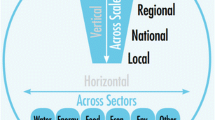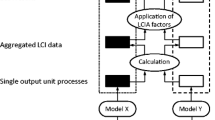Abstract
Purpose of Review
The purpose of this review is to discuss challenges regarding assembly and use of water-energy-food (WEF) nexus data.
Recent Findings
WEF nexus analysis endeavors including nexus-wide-scoped data are relatively new although component data has been gathered for years. However, such data are not frequently comprehensive across all WEF sectors nor are they typically integrated into a WEF wide system database. Data systems covering the full set of WEF domains are evolving and there are challenges that must be faced to better support WEF system wide analysis.
Summary
Nexus data must facilitate stakeholder and analyst understanding of nexus scope, locations, production, consumption, diversion, return flows, and conveyance possibilities along with costs. There is important need for data that supports efforts to understand system boundaries, and spatial dimensions, along with the origin and fate of WEF commodities plus cross-sector interactions and interfaces. A wide, rather comprehensive set of data are necessary across the full WEF scope as the nexus approach is about widening perspectives to unexplored levels. Additionally, WEF nexus data systems need to reflect study region uniqueness incorporating appropriate activities with contents varying as focus shifts from place to place. Challenges arise in representing appropriate scope, mix of enterprises, stochastic variation in water supplies, WEF commodity production practices, WEF commodity market prices, and costs and returns from ongoing and potential future technological choices. Data challenges arise due to proprietary interests, scale differences in analysis, model requirements, representation of unexplored possibilities, assembly cost, projections of the future, representation of stochastic variation, quick query and retrieval systems, and integration with visualization. Comprehensive, innovative procedures are needed for data collection, storage/retrieval and inference in support of high quality WEF nexus analyses.
Similar content being viewed by others
References
Papers of particular interest, published recently, have been highlighted as: • Of importance •• Of major importance
• Bazilian M, Rogner H, Howells M, Hermann S, Arent D, Gielen D, et al. Considering the energy, water and food nexus: towards an integrated modelling approach. Energy Policy. 2011;39:7896–906. Describes some of the linkages at a high level of aggregation and via case studies to arrive some promising directions for addressing the nexus.
Bizikova L, Roy D, Swanson D, Venema HD, McCandless M. The water-energy-food security nexus: towards a practical planning and decision-support framework for landscape investment and risk management. Winnipeg: The International Institute for Sustainable Development. 2013.
Kraucunas I, Clarke L, Dirks J, Hathaway J, Hejazi M, Hibbard K, et al. Investigating the nexus of climate, energy, water, and land at decision-relevant scales: the Platform for Regional Integrated Modeling and Analysis (PRIMA). Clim Chang. 2015;129:573–88.
•• Miralles-Wilhelm F. Development and application of integrative modeling tools in support of food-energy-water nexus planning—a research agenda. J Environ Stud Sci. 2016;6:3–10. Discusses broad nexus issues and modeling thereof.
Ringler C, Bhaduri A, Lawford R. The nexus across water, energy, land and food (WELF): potential for improved resource use efficiency? Curr Opin Environ Sustain. 2013;5:617–24.
Daher BT, Mohtar RH. Water–energy–food (WEF) Nexus Tool 2.0: guiding integrative resource planning and decision-making. Water Int. 2015;40:748–71.
Wang X, Williams JR, Gassman PW, Baffaut C, Izaurralde RC, Jeong J, et al. EPIC and APEX: model use, calibration, and validation. Trans ASABE. 2012;55:1447–62.
Hoogenboom G, Jones J, Wilkens P, Porter C, Boote K, Hunt L, et al. Decision support system for agrotechnology transfer (DSSAT) 2015, Version 4.6. 1. DSSAT Found. Available from: http://dssat.net/
Arnold JG, Moriasi DN, Gassman PW, Abbaspour KC, White MJ, Srinivasan R, et al. SWAT: model use, calibration, and validation. Trans ASABE. 2012;55:1491–508.
Gillig D, McCarl BA, Boadu F. An economic, hydrologic, and environmental assessment of water management alternative plans for the south Central Texas region. J Agric Appl Econ. 2001;33:59–78.
Ohrel SB, Beach RH, Adams D, Alig R, Baker J, Latta GS, et al. Model documentation for the forest and agricultural sector optimization model with greenhouse gases (FASOMGHG). RTI Int. [Internet]. 2010; Available from: http://agecon2.tamu.edu/people/faculty/mccarl-bruce/FASOM.html
Loulou R, Goldstein G, Noble K, et al. Documentation for the MARKAL Family of Models. Energy Technol Syst Anal Program. 2004; Available from: http://www.etsap.org/MrklDoc-I_StdMARKAL.pdf.
Pfenninger S, Hawkes A, Keirstead J. Energy systems modeling for twenty-first century energy challenges. Renew Sust Energ Rev. 2014;33:74–86.
IMPLAN v3 Software manual [Internet]. 2016. Available from: http://support.implan.com/index.php?view=download&alias=32-piaia-sample&category_slug=demo-1&option=com_docman&Itemid=1764
Harbaugh AW. MODFLOW-2005, the US geological survey modular ground-water model: the ground-water flow process [internet]. USA: US Department of the Interior, US Geological Survey Reston; 2005. [cited 2017 May 16]. Available from: http://md.water.usgs.gov/gw/modflow/MODFLOW_Docs/TM6-A16-MODFLOW-2005.pdf
• McCarl BA, Musumba M, Smith JB, Kirshen P, Jones R, El-Ganzori A, et al. Climate change vulnerability and adaptation strategies in Egypt’s agricultural sector. Mitig Adapt Strateg Glob Chang. 2015;20:1097–109. Good study to highlight the implications of climate change effects on crop yields, livestock performance, non-agricultural water use, water supply, irrigation water use, sea level rise and a growing population.
Murray BC, McCarl BA, Lee H-C. Estimating leakage from forest carbon sequestration programs. Land Econ. 2004;80:109–24.
Searchinger T, Heimlich R, Houghton RA, Dong F, Elobeid A, Fabiosa J, et al. Use of US croplands for biofuels increases greenhouse gases through emissions from land-use change. Science. 2008;319:1238–40.
Texas Water Development Board, South Central Texas regional water planning area, Regional Water Plan Volume 1. 2016 Available from: http://www.regionltexas.org/wp-content/uploads/2015/12/RegionL-2016-RWP-Volume_1.pdf
Klein R, Midgley G, Preston B, Alam M, Berkhout F, Dow K, et al. Adaptation opportunities, constraints and limits. Impacts, adaptation and vulnerability. 2014 [cited 2017 May 16]; Available from: https://researchbank.rmit.edu.au/view/rmit:37225
Chambwera M, Heal G, Dubeux C, Hallegatte S, Leclerc L, Markandya A, et al. Economics of adaptation. 2014 [cited 2017 May 16]; Available from: http://pure.iiasa.ac.at/11126
Acknowledgements
This research was partially supported by the Texas A&M WEF Nexus initiative plus an NSF FEW Nexus grant entitled “A Modeling Framework to Couple Food, Energy, and Water in the Teleconnected Corn and Cotton Belts.”
Author information
Authors and Affiliations
Corresponding author
Ethics declarations
Conflict of Interest
Bruce A. McCarl, Yingqian Yang, Raghavan Srinivasan, Efstratios N. Pistikopoulos, and Rabi H. Mohtar declare no conflicts of interest.
Human and Animal Rights and Informed Consent
This article does not contain any studies with human or animal subjects performed by any of the authors.
Additional information
This article is part of the Topical Collection on Nexus of Food, Water, Energy
Rights and permissions
About this article
Cite this article
McCarl, B.A., Yang, Y., Srinivasan, R. et al. Data for WEF Nexus Analysis: a Review of Issues. Curr Sustainable Renewable Energy Rep 4, 137–143 (2017). https://doi.org/10.1007/s40518-017-0083-3
Published:
Issue Date:
DOI: https://doi.org/10.1007/s40518-017-0083-3




